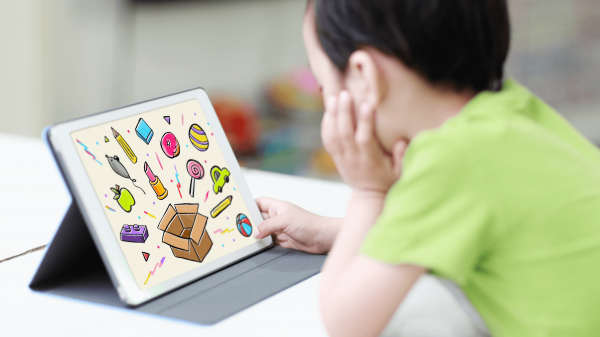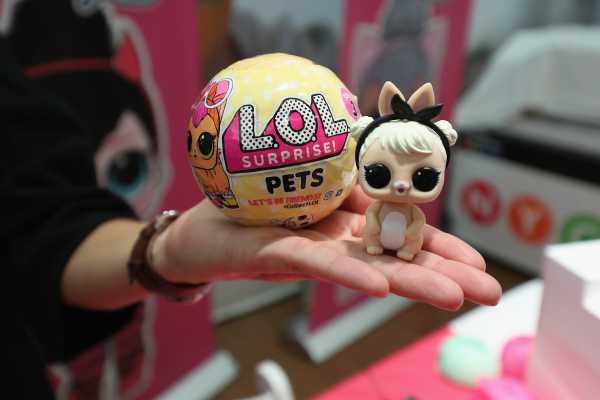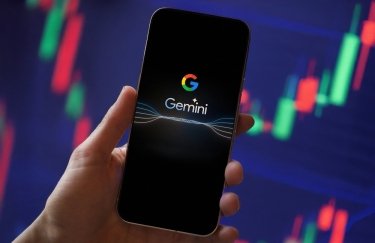
Toy unboxing videos have taken over YouTube. Some experts say they exploit kids.
Does YouTube’s toy unboxing industry need better regulation to shield children from advertisers?
By
Chavie Lieber@ChavieLieber
Updated
Mar 22, 2019, 6:03pm EDT
Share
Tweet
Share
Share
Toy unboxing videos have taken over YouTube. Some experts say they exploit kids.
tweet
share

This January, the public prosecutor’s office in São Paulo, Brazil, announced it was suing Google, accusing its video-sharing platform YouTube of “engaging in abusive advertising practices toward children.”
How is YouTube allegedly abusing children? Through toy unboxing videos, a genre beloved by billions of children around the world, in which toys are opened and played with. This type of kids’ content, the suit posits, largely exist as a form of advertising — and in Brazil, it is illegal to advertise to children 12 and under.
Unboxing videos, in general, are massively popular on YouTube. A 2014 Google study on the trend found that one in five shoppers consult an unboxing video before they buy something. Unboxing videos have even become their own weird category of entertainment, and it has children hooked.
By the modern definition, videos like these often are ads, known as sponsored content. Toy companies look to YouTube and its army of influencers to spread the word about their products, sometimes paying them top dollar for sponcon and, at the minimum, sending them toys for free.

But while brands and YouTube have strict
In a statement to Vox, YouTube said:
This current lawsuit highlights the issues inside the giant, lucrative, and often shady world of toy unboxing that have been going on for years on YouTube. In the US, children’s television programming and the advertising that airs during commercial breaks has been regulated by the Federal Communications Commission since the ’90s. Regulation for content on YouTube, on the other hand, is lax and obscure.
“Unboxing toy videos [are] abusive to kids because kids lack judgment and experience,” says Ekaterine Karageorgiadis, a program coordinator at the Brazilian childhood well-being nonprofit Alana Institute, who is one of the advocates pushing for action against YouTube. “The main goal is to sell. How is it not advertising?”
“Unboxing toy videos [are] abusive to kids because kids lack judgment and experience”
Approximately 300 hours’ worth of content is uploaded to YouTube every minute, and one-fifth of the platform’s top 100 channels with the most subscribers are about toys. The world’s largest market for toys is the US; in 2017, American shoppers spent $4.5 billion on toys on Amazon alone. Toy unboxing has become a global trend, and parents in the US are keenly aware of the videos creeping into their kids’ lives. Karageorgiadis says plenty of parents in Brazil are already cautious that YouTube has become a kind of QVC for toys but can’t escape these videos because YouTube’s algorithm keeps promoting them. Parents stateside are having the same experience.
“YouTube absolutely pushes him,” one parent posted on Reddit about a YouTube toy influencer. “I erase the history and search and no matter what, he is there!!”
Tiffany Bell, the 26-year-old influencer behind the YouTube channel Oh Cluck Toys, plays with toys for a living.
“I’ve always loved toys, especially anything plush, and I saw a few toy videos some years ago and I thought, ‘I can do that!’” she tells me during an interview at the Toy Fair New York. “I’m having a good time with it.”
Bell is shy and soft-spoken IRL, but is animated and goofy onscreen. Her videos of the Japanese collectible dolls Tsum Tsums receive millions of hits, as do her toy hunts, where she’ll head to a store to look for toys like L.O.L. Surprise! Dolls.
Bell says she doesn’t do any sponsored content, but she does get tons of toys sent to her from basically every major brand (most of which she donates). For the once-aspiring actress and toy fanatic, playing with toys on camera is a dream career. Bell asserts she participates in this world for herself and for her fans, and does not feel like she’s working for any brand.
Not everyone sees it so innocently. Karageorgiadis says she finds YouTube influencers to be acting as sellers, even if they don’t see themselves that way. “Children watching these unboxing videos establish a trust and believe anything they say,” she says. “They want to be that girl on the screen; they believe them to be their friend and that they are showing them stuff as a friend.”
Nearly every toy company works with toy influencers, either sending them toys for free, like Bell, or paying them money for sponsored content. Some YouTube creators are even taking home huge paychecks, like Ryan, the 8-year-old toy influencer from Ryan ToysReview, who made $22 million last year, according to Forbes.
While Ryan is the top earner in this world, there are other toy influencers making a serious profit. The creators of the kids toy channel KidToyTesters told Bloomberg in 2017 that they make $140,000 a year by doing sponsored videos with companies including Nintendo. The father of Evan, another toy influencer from the popular channel EvanTube HD, told Fast Company the family makes $1.3 million annually on Google and AdSense ad embeds.
Jonathan Berkowitz, the president of Hasbro, says YouTube clearly has its benefits when it comes to influencers getting the word out about the company’s products.
“TV commercials give you 15 seconds to communicate what the key thing is about, but YouTube gets you minutes, sometimes hours,” Berkowitz says.
“TV commercials give you 15 seconds … but YouTube gets you minutes, sometimes hours”
Isaac Larian, the CEO of MGA Entertainment, the company behind Bratz and the wildly successful L.O.L. Surprise! Dolls that were created with YouTube in mind, calls MGA’s work with YouTubers a crucial part of the company’s marketing effort.
“When they do an unboxing video of one of our toys, the number of their subscribers go up, and they make money, and they drive interest for us,” he says. “It’s a circle, and it’s become its own advertising universe.”
This is precisely where things get sticky. That these brands are sponsoring toys or paying YouTubers top dollar to make content is the root of the lawsuit against YouTube in Brazil. It’s also what concerns parents and consumer advocates in the US.
“This content is unfair because it’s an ad disguised as a fun video, and the influencers are very very good at making kids feel like they are watching the most fun toy out there,” says Josh Golin, the executive director of the nonprofit Campaign for a Commercial-Free Childhood. “It’s also deceptive to parents because they have zero understanding of what their kids are watching.”

For decades, kids’ television programming in the US has been regulated by the Federal Communications Commission. The Children’s Television Act of 1990 outlines specific requirements on how content must have educational components; there are also limits to the length of ads and bans on commercials running during related programming. (Paw Patrol products, for example, are not allowed to be advertised during Paw Patrol shows on Nickelodeon.)
Rules like these are nonexistent on YouTube, and Golin points out that unboxing videos “would never be allowed on children’s television.” Parents have noticed there’s something eerily promotional about them.
“This is completely not what I want my child to witness as ‘fun,’” one parent wrote on an internet safety forum. “I have deleted YouTube Kids from my child’s device because he was beginning to think that all families live like this — $1,000s worth of new toys every week.”
“Block any kind of toy review, unboxing videos, or ‘surprise egg’ stuff,” another warned on Reddit. “One may think it’s ok, taken in small doses in the beginning, but it’s absolutely crack.”
Like every social media platform, YouTube has
But Angela Campbell, a law professor at Georgetown and co-director of the Institute for Public Representation Communications and Technology Clinic who’s studied toy unboxing videos, has filed complaints to the FTC because she rarely sees
Not that #sponcon indicators would necessarily matter. Research studies have found that children under the age of 8 do not have the cognitive capability of “persuasive intent,” or the understanding that they are being sold something. The American Psychological Association has warned that advertising to children is unfair because they are “easy targets for commercial persuasion.”
There’s also the fact that while many children feel a strong connection to the creators they watch, the identity of many of these YouTubers is a complete mystery. The popular channel FunToys Collector Disney Toys Review has 11 million subscribers and makes about $5 million a year; the creator only shows her hands and speaks in a childlike voice. In 2015, her identity was reportedly exposed as Orlando-based Brazilian porn actress Sandy Summers.
A former porn actress finding a new job in toys isn’t grounds for panic. But it does highlight the concerns of how anonymous YouTube can be. Plus, an unregulated, faceless digital playground can leave young users vulnerable. Earlier this month, it was revealed that an alleged “network of pedophiles” was leaving sexually suggestive comments about young children in its comments section, which led companies to pull their ads. YouTube deleted hundreds of accounts and eventually shut down the comments section on videos with minors. It was a rare move of the company responding to public outcry. YouTube told Vox in a statement that it would “continue to work to improve and catch abuse more quickly.”
Videos designated as kids’ content also aren’t always what they seem. There are videos of adults dressing up as superheroes and doing strange and sometimes inappropriate things (known as ElsaGate) that make their way through YouTube’s filter and onto the kids app. There’s also harmful content like suicide instructions spliced into kids programming. This kind of stuff makes its way to kids on YouTube because of the tech platform’s lack of regulation.
Even the straightforward unboxing videos that aren’t sponcon and don’t have harmful content draw concern. Golin, of CCFC, believes they send a message of materialism, since “all these videos talk about is how getting new toys and clothes will make us happy and cool.”
“All these videos talk about is how getting new toys and clothes will make us happy and cool”
Charlotte Keating, a child psychologist and neuroscientist who’s studied the unboxing trend, points out that the very nature of toy unboxing videos can be addictive for children. “From a neuroscience perspective, these videos can activate the release of dopamine from regions of the brain that are involved in motivation and reward,” she says. “It can lead to anticipation, or desire that isn’t ultimately fulfilled. If they’re viewing a lot of these videos or any other advertising, then they’re potentially going to want more of them, or the real thing. … They may become so obsessed with the object of desire that by the time they actually have it, the novelty has worn off.”
Unboxing videos have some psychological effects too, she adds. With the “priming effect,” consumers who are exposed to products, logos, and names eventually develop positive associations and reactions to them; this is basic science for why product placement and TV advertising affects consumer choices like food preferences, and it happens when kids watch toy unboxing videos, too.
Kids also develop a “mimetic desire,” a theory coined by anthropologist René Girard that explains desiring what other people have: “Instead of engaging in play and sharing the toy with a friend, the object of desire is being watched in their own home on a device as many times as they potentially like,” she explains.
Keating couches all this with a strong opinion that while not the greatest type of kids’ content, “there’s no evidence to suggest that watching toy videos and unboxing videos on YouTube causes harm.” She recommends that parents limit children’s exposure to it, like all screen time, and opt for “real-life play with peers and family.”
For all the fear, anxiety, and suspicion toward the toy unboxing world, it doesn’t change the fact that kids like this stuff: The hundreds of billions of views and an endless number of comments from young viewers are strong indicators.
While experts like Golin and Karageorgiadis believe that YouTube toy videos are manipulated by the ad dollars behind them, not everyone buys it.
“I believe this is a larger developmental misunderstanding; your children have grown up on these social networks, they know much more than you think they do,” says David Craig, a professor at the University of California’s Annenberg School for Communication and Journalism and the author of an in-depth research paper on the topic.
“In the minds of kids, more likely, the blurred lines are able to exist,” Craig goes on. “There’s little to suggest that kids are watching these videos to covet toys. They are really just socializing and playing virtually with kids online.”
Jarrod Walczer, a researcher working under Craig who’s writing a book about toy unboxing, believes there’s far more to be celebrated in toy unboxing than vilified.
“Kids get gratification out of these videos,” he says. “When they watch a video of Ryan, they feel a sense of kinship. And in an age of the neoliberalization of parenting, moms and dads working longer hours, kids need a space for comfort and these [videos] give them that.”
“Kids get gratification out of these videos. When they watch a video of Ryan, they feel a sense of kinship.”
Craig compares the angst surrounding toy unboxing to the “moral panic” video games caused in the ’90s. He also notes that YouTube has paved the way for an unprecedented democratization for access and income: Kids who can’t afford toys can now watch videos about them for free instead, and anyone can now make money off of the toy industry.
“We’ve fought for hundreds of years for people to create their own culture and content, as opposed to have gatekeepers like the government dictate what gets seen and shown,” Craig says. “Do we really want to reinforce the gatekeeping we fought by asking the government to start regulating this?”

Craig admits toy unboxing videos can seem like “Christmas morning every morning.” But Walczer says there are plenty of creators trying to make unboxing videos with an educational twist. The problem, of course, is that YouTube’s algorithm buries them in favor of quick-hit viral content.
Like many tech companies, YouTube has a hands-off approach to many discussions about its platform, including the issues consumerism advocates and parents have about its toy unboxing videos. (I asked YouTube to comment several times for this story and did not hear back.)
But the platform is now a key source of children’s entertainment and a major influence for the toy industry, whether or not it wants to admit it. Walczer believes YouTube should start taking more responsibility and be in the business of promoting educational content.
Not only would moves like these help YouTube escape concerns of commercial abuse, it would ease the anxieties of worried parents. The unboxing videos genre is only going to grow. Kids have always loved the boxes toys come in; these videos are just the latest version.
Update 3/22: Updated to add statement from YouTube.
Want more stories from The Goods by Vox? Sign up for our newsletter here.
Sourse: vox.com






